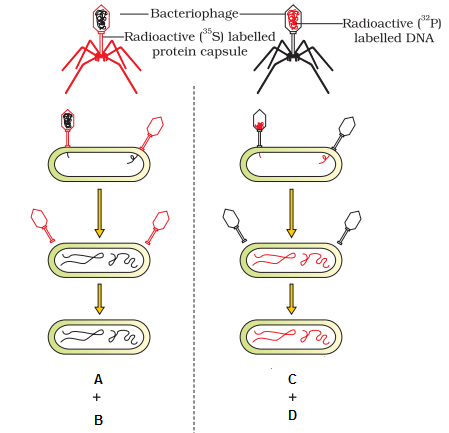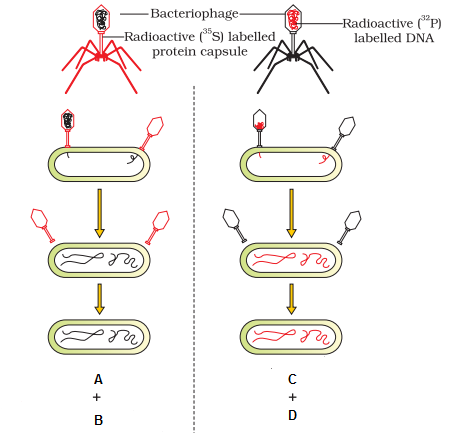In eukaryotes the gene expression is regulated at:
A. Transcriptional level
B. Processing level
C. Transport of mRNA from nucleus to the cytoplasm
D. Translational level
(a) A, C (b) A, B, C, D (c) B, C, D (d) A, B, C
सुकेन्द्रकों में जीन अभिव्यक्ति को विनियमित करता है:
A. अनुलेखीय स्तर
B. प्रसंस्करण स्तर
C. केंद्रक से कोशिकाद्रव्य तक mRNA का परिवहन
D. स्थानांतरीय स्तर
(a) A, C (b) A, B, C, D (c) B, C, D (d) A, B, C
A. Transcriptional level
B. Processing level
C. Transport of mRNA from nucleus to the cytoplasm
D. Translational level
(a) A, C (b) A, B, C, D (c) B, C, D (d) A, B, C
B. प्रसंस्करण स्तर
C. केंद्रक से कोशिकाद्रव्य तक mRNA का परिवहन
D. स्थानांतरीय स्तर
(a) A, C (b) A, B, C, D (c) B, C, D (d) A, B, C
In prokaryotes, gene regulation occurs at the level of:
(a) Transcription (b) Translation
(c) Post transcription (d) Post translation
असीम केंद्रकी में, जीन विनियमन निम्नलिखित स्तर पर होता है:
(a) अनुलेखन (b) स्थानांतरण
(c) अनुलेखन के बाद (d) स्थानांतरण के बाद
Characteristic(s) of most DNA is / are:
A. A pairs with T by 2 hydrogen bonds.
B. Antipolarity of complementary chains
C. 20Ao diameter
D. 10 bps / turn
(a) A, C (b) A, B, C, D (c) B, C, D (d) A, B, C
अधिकांश DNA की विशेषता है / हैं:
A. 2 हाइड्रोजन बंध के द्वारा T के साथ एक युग्म।
B. पूरक श्रृंखलाओं की प्रतिध्रुवता
C. 20Ao व्यास
D. 10 bps / turn
(a) A, C (b) A, B, C, D (c) B, C, D (d) A, B, C
A. DNA polymorphism plays important role in evolution and speciation.
B. 99.9% nucleotides bases are exactly same in all people
C. Chromosome 1 has the fewest genes (23) and Y-chromosomes has most genes (2968)
D. BAC and YAC have been used in Human Genome Project.
(a) All correct (b) All incorrect
(c) A, B, D are correct (d) B, C, D are correct
A. डीएनए बहुरूपता, विकास और जातिउद्भवन में महत्वपूर्ण भूमिका निभाता है।
B. 99.9% न्यूक्लियोटाइड्स क्षार सभी लोगों में बिल्कुल समान होते हैं
C. गुणसूत्र 1 में न्यूनतम जीन (23) और Y-गुणसूत्र में अधिकतम जीन (2968) होते हैं।
D. मानव जीनोम परियोजना में BAC और YAC का उपयोग किया गया था।
(a) सभी सही (b) सभी गलत हैं
(c) A, B, D सही हैं (d) B, C, D सही हैं
Which one(s) is / are correct?
A. In prokaryotes single type of RNA polymerase can transcribe mRNA, tRNA and rRNA.
B. In eukaryotes RNA polymerase I transcribes rRNA (28s, 18s and 5.8s) whereas RNA pol III is responsible for transcription of tRNA, 5s rRNA and RNAs.
C. RNA pol II transcribes HnRNA in eukaryotes.
D. Ribosomal large subunit has p and A-sites.
(a) A, C (b) A, B, C, D (c) B, C, D (d) A, B, C
कौन सा सही है / हैं?
A. प्राककेंद्रकी में एकल प्रकार के RNA पॉलिमिरेज mRNA, tRNA और rRNA को अनुलेखित कर सकते हैं।
B. सुकेन्द्रकी में RNA पॉलिमिरेज I rRNA (28s, 18s और 5.8s) को अनुलेखित करता है जबकि RNA पोल III tRNA, 5s rRNA और RNA के अनुलेखन के लिए जिम्मेदार है।
C. सुकेन्द्रकी में RNA पोल II, HnRNA को अनुलेखित करता है।
D. बड़े राइबोसोमीय उपएकक में p और A-साइट होते हैं।
(a) A, C (b) A, B, C, D (c) B, C, D (d) A, B, C
Go through the following diagram of Nucleosome (structural unit of chromatin). Identify its componential parts indicated by A, B and C:
|
|
A |
B |
C |
|
(a) |
RNA |
Non histone |
Histone |
|
(b) |
DNA |
H1 histone |
Histone Octamer |
|
(c) |
RNA |
Histone Octamer |
H1 histone |
|
(d) |
DNA |
Non histone |
Histone |
न्यूक्लियोसोम (क्रोमेटिन की संरचनात्मक इकाई) के निम्नलिखित आरेख की जाँच करें। A, B और C द्वारा दर्शाए गए इसके नामांकित भागों को पहचानें:
|
|
A |
B |
C |
|
(a) |
RNA |
अहिस्टोन |
हिस्टोन |
|
(b) |
DNA |
H1 हिस्टोन |
हिस्टोन अष्टतय |
|
(c) |
RNA |
हिस्टोन अष्टतय |
H1 हिस्टोन |
|
(d) |
DNA |
अहिस्टोन |
हिस्टोन |
Following is the schematic structure of transcription unit having some important components indicated by A, B, C, D and E. In which of four option the components are identified correctly:
|
|
A |
B |
C |
D |
E |
|
(a) |
Terminator |
Transcription start site |
Promoter |
Template strand |
Coding strand |
|
(b) |
Promoter |
Transcription start site |
Terminator |
Coding strand |
Template strand |
|
(c) |
Promoter |
Transcription start site |
Terminator |
Template strand |
Coding strand |
|
(d) |
Terminator |
Transcription start site |
Promoter |
Coding strand |
Template strand |
अनुलेखन इकाई की व्यवस्थित संरचना निम्नलिखित है, जिसमें A, B, C, D और E द्वारा संकेतित कुछ महत्वपूर्ण घटक हैं। इन चार विकल्पों में से किन घटकों की सही पहचान की गई है:
|
|
A |
B |
C |
D |
E |
|
(a) |
समापक |
अनुलेखन प्रारंभिक स्थल |
प्रारम्भक |
टेम्पलेट रज्जु |
कूटलेखन रज्जुक |
|
(b) |
प्रारम्भक |
अनुलेखन प्रारंभिक स्थल |
समापक |
कूटलेखन रज्जुक |
टेम्पलेट रज्जु |
|
(c) |
उन्नायक |
अनुलेखन प्रारंभिक स्थल |
समापक |
टेम्पलेट रज्जु |
कूटलेखन रज्जुक |
|
(d) |
प्रारम्भक |
अनुलेखन प्रारंभिक स्थल |
प्रारम्भक |
कूटलेखन रज्जुक |
टेम्पलेट रज्जु |
The fact that the genetic code is almost universal in living organisms is considered to be evidence that all organisms:
(a) Are evolutionarily related
(b) Are genetically identical
(c) Have the same sequence of anticodons
(d) None of the above
तथ्य यह है कि सजीवों में आनुवंशिक प्रकूट लगभग सार्वभौमिक है, इस बात का प्रमाण माना जाता है कि सभी जीव:
(a) विकास से संबंधित हैं।
(b) आनुवंशिक रूप से समरूप हैं।
(c) प्रतिप्रकूट का एक ही अनुक्रम हैं।
(d) उपरोक्त में से कोई नहीं।
In the following diagram of the lac operon, an operon for inducible enzymes, identify components and enzymes:
|
|
X |
Y |
E1 |
E2 |
E3 |
|
(a) |
Repressor protein |
Inducer (lactose) |
â-Galactosidase |
Permease |
Transacetylase |
|
(b) |
Inducer (lactose) |
Repressor protein |
â-Galactosidase |
Permease |
Transacetylase |
|
(c) |
Repressor protein |
Inducer (lactose) |
â-Galactosidase |
Transacetylase |
Permease |
|
(d) |
Repressor protein |
Inducer (lactose) |
Permease |
Transacetylase |
â-Galactosidase |
निम्नलिखित आरेख में लैक प्रचालेक, प्रेरणीय एंजाइमों के लिए एक प्रचालेक, घटकों और एंजाइमों की पहचान कीजिए:
|
|
X |
Y |
E1 |
E2 |
E3 |
|
(a) |
दमनकारी प्रोटीन |
प्रेरक (लैक्टोज) |
â-गैलेक्टोसाइडेज |
पर्मिएज़ |
ट्रांसएसिटीलेज |
|
(b) |
प्रेरक (लैक्टोज) |
दमनकारी प्रोटीन |
â-गैलेक्टोसाइडेज |
पर्मिएज़ |
ट्रांसएसिटीलेज |
|
(c) |
दमनकारी प्रोटीन |
प्रेरक (लैक्टोज) |
â-गैलेक्टोसाइडेज |
ट्रांसएसिटीलेज |
पर्मिएज़ |
|
(d) |
दमनकारी प्रोटीन |
प्रेरक (लैक्टोज) |
पर्मिएज़ |
ट्रांसएसिटीलेज |
â-गैलेक्टोसाइडेज |
Alfred Hershey and Martha Chase made a big contribution in proving DNA role as the hereditary molecule. The experiment is shown in the diagram. A and C are the presence or absence of radioactivity detected in cells B and D are the presence or absence of radioactivity detected in supernatants cells. Identify A, B, C and D:

(a) A - No Radioactivity (35S) detected in cells; B - Radioactivity (32P) detected in supernatant; C - Radioactivity (35S) detected in cells; D - No Radioactivity in supernatant
(b) A- Radioactivity (35S) detected in cells; B - No Radioactivity (35S) detected in supernatant; C - Radioactivity (32P) detected in cells; D - No Radioactivity in supernatant
(c) A - No Radioactivity (35S) detected in cells; B - Radioactivity (35S) detected in supernatant; C - Radioactivity (32P) detected in cells; D - No Radioactivity in supernatant
(d) A - No Radioactivity (35S) detected in cells; B - Radioactivity (35S) detected in supernatant; C - No Radioactivity (32P) detected in cells; D - Radioactivity in supernatant
अल्फ्रेड हर्शे और मार्था चेज़ ने वंशानुगत अणु के रूप में डीएनए की भूमिका को साबित करने में एक बड़ा योगदान दिया। प्रयोग आरेख में दिखाया गया है। A और C कोशिकाओं में पाए जाने वाले रेडियोधर्मिता की उपस्थिति या अनुपस्थिति हैं B और D अधिप्लवी कोशिकाओं में पाए जाने वाले रेडियोधर्मिता की उपस्थिति या अनुपस्थिति हैं। A, B, C और D की पहचान करें:

(a) A - कोशिकाओं में कोई रेडियोधर्मिता (35S) नहीं पायी गयी; B - अधिप्लवी में रेडियोधर्मिता (32P) पायी गयी; C - कोशिकाओं में रेडियोधर्मिता (35S) पायी गयी; D - अधिप्लवी में कोई रेडियोधर्मिता नहीं
(b) A- रेडियोधर्मिता (35S) कोशिकाओं में पायी गयी; B - अधिप्लवी में रेडियोधर्मिता (35S) पायी गयी; C - कोशिकाओं में रेडियोधर्मिता (32P) पायी गयी; D - अधिप्लवी में कोई रेडियोधर्मिता नहीं
(c) A - कोशिकाओं में कोई रेडियोधर्मिता (35S) नहीं पायी गयी; B - अधिप्लवी में रेडियोधर्मिता (35S) पायी गयी; C - कोशिकाओं में रेडियोधर्मिता (32P) पायी गयी; D - अधिप्लवी में कोई रेडियोधर्मिता नहीं
(d) A - कोशिकाओं में कोई रेडियोधर्मिता (35S) नहीं पायी गयी; B - अधिप्लवी में रेडियोधर्मिता (35S) पायी गयी; C - कोशिकाओं में कोई रेडियोधर्मिता (32 P) नहीं पायी गयी; D - अधिप्लवी में रेडियोधर्मिता









